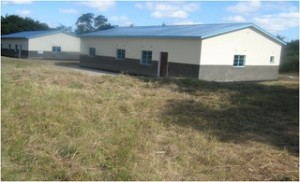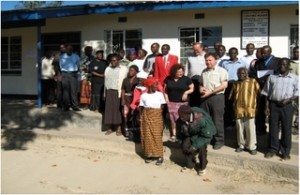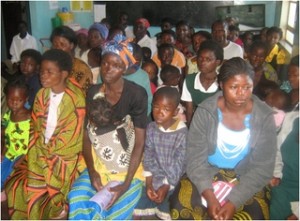Mulanga Zonal Rural Health Centre
Managing agency: Religious Sisters of Charity
Mulanga Rural Health Centre
P.O BO 48170 CHINSALI
Muchinga Province
ZAMBIA
Cellphone no: +260 097661687
Vision Statement:
To have a disease free community where everyone contributes significantly to the integral development of the country.
Mission Statement:
To offer quality primary health care services to all with support of the community stakeholders, ministry of health and other cooperating partners.
1. Center Profile:
1.1 Overview
GEOGRAPHICAL: Mulanga is a Mission Health Centre in Chinsali District in the Northern Province of Zambia. It is south east of Chinsali, 75km from the Chinsali Boma and 16km off the great north road at Matumbo junction.
Mulanga has a big catchment area. Most of the area is on the highlands of the muchinga escarpment with sandy loam, alluvian type of soil with savanna type of grass and woodlands. The area has abundant natural resources and is ideal for arable and pastoral farming, game is abundant and eco–tourism.

1.2 Demographical Profile
According to central statistic office Mulanga’s population will rise by 3.8% per year. The catchment area population has a linear and cluster type of settlements. The areas highly populated areas are Mulanga, Katoma, Chabola, Kalikiti.
| CATEGORY | % | NUMBER, POPULATION AND YEAR | ||||||||
| 2006 | 2007 | 2008 | 2009 | 2010 | ||||||
| Children 0-11 months | 4 | 547 | 568 | 590 | 611 | 646 | ||||
| Children < 5 yrs | 20 | 2734 | 2842 | 2950 | 3054 | 3233 | ||||
| Children 5-14 yrs | 48.8 | 6671 | 6935 | 7198 | 7453 | 7889 | ||||
| Women 15-45 yrs | 22 | 3012 | 3126 | 3245 | 3360 | 3556 | ||||
| All adults 15yrs + | 40 | 5476 | 5684 | 5905 | 6109 | 6466 | ||||
| Total males all ages | 48.8 | 6671 | 6984 | 7198 | 7453 | 7889 | ||||
| Total females all ages | 51.2 | 6970 | 7276 | 7552 | 7974 | 8277 | ||||
| TOTAL POPULATION | 100 | 13,671 | 14,211 | 14,751 | 15,575 | 16,166 | ||||
1.3 Social economical profile.
Bisa is the dominant ethnic language group in Mulanga. Bemba, Bisa and Chitumbuka are widely spoken languages.
Most Christian denominations are present in the area, the main religious churches being, Catholic Church and United Church of Zambia but also Pentecostal churches and to a smaller extent traditionist.
The people engage in small scale farming for their livelihood, cash crops such as maize, millet, Cassava, groundnuts etc are grown. Small scale trade in finished goods is also practiced and batter system is widely used as a form of trade.
2. Buildings
The clinic infrastructure is in a relatively good condition except
– Kitchen and laundry block which requires extensive renovations.
– The plumbing system for the whole clinic has constant leaks and burst of water pipes due to rust. The whole system needs to be redone with PVC pipes.
– The clinic will need a new coat of painting in the next year.
The in-patient department comprises seven wards; two children’s wards, a female ward, male ward, isolation ward, labor ward and maternity ward and an antenatal clinic. The clinic has adequate ablution facilities. The clinic was kept clean all the time by a committed team of supportive staff.
The out-patient comprises two pharmacies, a counseling room, screening room, dressing room, small laboratory space and partitions for waiting or reception area and dispensary area.
– There is need to extend the laboratory to accommodate the ever increasing demand for diagnostic tests especially the HIV Test.
– The VCT room is small and situated in a place where privacy is compromised sometimes not accessible as it is a multipurpose room for other activities such as TB screening room, second OPD screening room and ART room.
– The pharmacy will require expansion and inclusion of air conditioning.
Other notable buildings are the children’s clinic shelter, mothers waiting shelter, the hammer mill and eight staff houses.
– The mothers waiting shelter is not adequate and safety is compromised. In order for mothers to be encouraged to come for hospital deliveries there is need to expand and furnish to make it more comfortable.
– One old house was renovated within the year to an amount of ZMK 10,000,000.
– Five houses need extensive renovation especially plumbing works for staff to be comfortable.

Two new houses awaiting electrification
2.1 Utilities
– The centre is connected to the national grid and has electricity 24 hours a day. Except in the rain season when prolonged interruptions are experienced due transformer blow out.
– There is need to invest in solar lighting to counteract these outages.
– The centre has a vehicle which will be a year old early 2010. It is used for programs, patient referral and administrative trips.
– There is need to acquire a second vehicle so that the tear and wear is less on a single vehicle considering the bad roads in this part of the country and the many trips it has to make.
3. Human Resource:
| POSITION | ESTABLISHMENT | AVAILABLE | SHORTFALL |
| REGISTERED MIDWIVES | 0 | 2 | 0 |
| CLINICAL OFFICER | 2 | 0 | 2 |
| ENROLLED MIDWIVES | 4 | 0 | 4 |
| ENROLLED NURSES | 5 | 2 | 3 |
| ENV. HEALTH. TECHNICIAN | 1 | 1 | 0 |
| LABORATORY TECHNICIAN | 1 | 0 | 1 |
| STATION HANDMAN | 1 | 1 | 0 |
| CLASSIFIED DAILY EMPLOYEES | 5 | 5 | 0 |
| SECURITY GUARDS | 1 | 1 | 0 |
| Total | 20 | 10 | 10 |
The Ministry of Health continued staff restructuring saw the arrival of an enrolled nurse in March 2009 and an environmental technologist in September of the same year however there is still critical shortage of skilled manpower as you can see above.

Staff with Community Stakeholders and Partners
4. Public Health Service Delivery
The health service delivery priority interventions were as per National Health Strategic Plan 2006 – 2010:
Selected objectives are such as:
| HEALTH THRUST | OBJECTIVE | |
| 1. | Child health and nutrition | To reduce the mortality rate among the under five by two third |
| 2. | Integrated Reproductive Health | To reduce maternal mortality ratio by three quarter |
| 3. | HIV/AIDS, TB, STIS | To halt and begin to reduce the spread of HIV, TB and STIs through effective interventions |
| 4. | Malaria | To reduce the incidence and mortality due to malaria |
| 5. | Epidemics & Public Health
Surveillance and Control |
To improve public health surveillance and control of epidemics |
| 6. | Environmental health and food safety | To promote and implement appropriate interventions aimed at improving hygiene, access to basic sanitation, safe water and safe food. |
| 8. | Other communicable and non-communicable diseases | To significantly strengthen the delivery of other relevant interventions in communicable and non-communicable diseases |
| 9. | Human Resource | To recruit, train and retain appropriate and adequate staffing |
| 10. | Essential drugs and medical supplies | To ensure availability of adequate, quality and efficacious, safe and affordable essential drugs and medical supplies at all levels. |
| 11. | Infrastructure and equipment | To strengthen infrastructure and medical equipment for effective delivery of key health services |
These priority programs served as a reference for the 2009 annual budget and shall be so till 2010. The funding was such that it was small and erratic making it very difficult to make significant progress in most or all of the above targeted indicators.
5. Funding
5.1 Government funding 2009
| MONTH | BUDGET | AMOUNT RECIEVED |
| January | 9,476,992 | 4,870,000 |
| February | 8,290,742 | 8,733,000 ( 5,000,000 Community) |
| March | 8,669,541 | 6,028,000 |
| April | 8,290,742 | 4,304,600 |
| May | 8,669,541 | 3,789,363 |
| June | 9,098,194 | 2,881,950 |
| July | 8,290,742 | forfeited |
| August | 8,290,742 | 5,996,500 |
| September | 8,669,540 | 2,486, 685 |
| October | 8,290,540 | 8,210,470 |
| November | 8,669,541 | 0 |
| December | 8,290,742 | 0 |
| Total | 102,997,599 | 47,300,568.49 |
5.2 Other Funds
The centers cooperating partners subsidized a lot for the centre to carry out both curative and preventive services.
A. CORDAID were our main funders through the Diocese under pay for performance in selected indicators which were:
1. Availability of essential drugs and medical supplies
2. Institutional deliveries
3. VCT and improved Patient care.
Once the indicators were achieved the centre was awarded an incentive.
Overview of CORDAID Funding
| DATE | ITEM | INCOME | EXPENDITURE | BALANCE |
| 1.01.09 | 466,214 | |||
| 5.06.09 | 38,250,000 | 38,716,214 | ||
| 30.06.09 | 34,466,817 | 4,249,397 | ||
| Interest | 874,385.13 | 5,123,782.13 | ||
| 5.09.09 | 70,547,788 | 75,671,570.13 | ||
| 31.12.09 | 18,433,605 | 57,237,965.13 | ||
| 31.12.09 | 109,672,173.13 | 52,900,422 | 57,237,965.13 |
B. BEIT TRUST funded the facility to purchase a delivery bed in the first quarter.
C. Individuals and friends of the Facility through the Sisters of Charity donated amounts which went into running costs.
D. The centre also undertook Income Generating Projects notable the hammer mill whose income is seasonal and a small tuck-shop whose income went to paying wages for three workers and running costs.
6. Curative Care Contacts: HMIS Data
| OUT-PATIENT VISITS | 2006 | 2007 | 2008 | 2009 |
| First attend under 5 | 1,903 | 1,831 | 4,824 | 4,943 |
| First attend 5 and over | 1,841 | 2,646 | 6,145 | 6,685 |
| Total first attendance | 3,744 | 4,477 | ||
| Re-attendances under 5 | 4,223 | 3,423 | ||
| Re-attendances 5 and over | 4,711 | 3,906 | ||
| Total re-attendances | 8,934 | 7,344 | ||
| Total ATTENDANCES | 12,678 | 11,821 | 10,969 | 11,628 |
| IN-PATIENT ADMISSIONS | ||||
| Under 5 | 573 | 574 | 623 | 832 |
| 5 and over | 621 | 614 | 622 | 954 |
| Total Admissions | 1,194 | 1,188 | 1,245 | 1,786 |
| DEATHS | ||||
| Under 5 | 16 | 16 | 15 | 15 |
| 5 and over | 8 | 4 | 9 | 11 |
| Total Deaths | 24 | 20 | 24 | 26 |
Out-patient department opened from Monday to Saturday from 08:30hrs to 11:30hrs for all cases; emergencies were seen twenty four hours a day.
In-patient operated twenty four hours a day on an eight hour shift. A daily Rota was drawn at the beginning of the month and daily duty allocation was in use.
In-patients were observed, treated and looked after up to a maximum of four days after which they were referred if there was no improvement. The available staff attended to both out-patients and in-patients.

OPD PATIENTS
Five top diseases attended to in OPD in the under 5s:
| DIAGNOSES | OUT-PATIENT DEPARTMENT | |
| 1. | Malaria | 1,210 |
| 2. | Non-pneumonia | 1,189 |
| 3. | Diarrhea | 305 |
| 4. | Pneumonia | 253 |
| 5. | Skin infections | 211 |
Five top diseases attended to in IPD in the under 5s.
| DIAGNOSES | IN-PATIENT DEPARTMENT | |
| 1. | Malaria | 511 |
| 2. | Pneumonia | 197 |
| 3. | Non – blood diarrhea | 148 |
| 4. | Non – pneumonia | 117 |
| 5. | Skin diseases | 41 |
Five top diseases attended to in OPD: (5years & over)
| DIAGNOSES | OUT-PATIENT DEPARTMENT | |
| 1. | Non-pnemonia | 1,533 |
| 2. | Malaria | 1,138 |
| 3. | Muscular Skeletal | 455 |
| 4. | Trauma | 266 |
| 5. | Digestive system | 228 |
Five top causes of deaths in the under fives
| DIAGNOSES | NUMBER OF DEATHS | |
| 1. | Pneumonia | 3 |
| 2. | Malnutrition | 3 |
| 3. | Malaria | 2 |
| 4. | Non- blood diarrhea | 2 |
| 5. | Prenatal | 2 |
6.1 Health Centre Self Assessment 2009
This was done quarterly on these selected indicators by the centre staff and shared with the community stakeholders.
| INDICATOR | EXPECTED RANGE | RANGE
ACHIEVED |
NEED INVESTIGATION- analysis |
| Malaria | 85-115% | 81% | Most fever cases were sent to the lab for malaria slides. Blind treatment was discouraged. |
| Proportion of women seeking antenatal services | 80% | 82% | Achieved |
| Mothers protected against tetanus toxoid | 70% | 92% | Achieved |
| Proportion of mothers delivering at the centre | 40% | 36% | Most mothers stay far from health centre more than 12 kms. |
| Couples accessing family planning | 611 | Failure rate is high as mothers are taught husbands are shy to come for these lessons. | |
| Clients presenting with STIS | 85-115% | 87% | Achieved |
| Pneumonia in the under 5s | 85-115% | 435% | Misdiagnosis was the root cause for the increase |
| Diarrhea cases in the under 5s | 85-115% | 161% | Most water sources are not clean and safe especially in the dry season when water levels are low. |
| Coverage for under 1s fully immunized | 70% | 88% | Achieved |
| Under 5s who are under weight | 14,247: U5s weighed | 197 under weight: 1% | Improve on tallying |
Table 11
6.2 Drugs and medical Supplies
Drugs were ordered monthly. A total of 18 kits were received from the district coupled with supplementary drugs. Vaccines were also ordered from the district pharmacy.
– Action medeo from German sent drugs through the post and container parcels. These were mostly infant syrups but also valuable medical supplies.
– Quarterly drugs were bought using donated money from well wishers.
7. Supportive Services
7.1 Laundry
The laundry facility is basic and hospital linen was hand washed. The supportive staff took turns to launder the bed linen after patients had been discharged. In the third quarter of the year under review a washing machine was purchased using CORDAID Funds.
7.2 Kitchen
The in-patients had three meals a day; breakfast of meal porridge with peanut butter, lunch and supper were provided using a set menu. Feeding patients was not easy especially with reduced and erratic funding.
Adjacent to the kitchen block is a small garden in which we grew vegetables for patients.
8. Preventive and promotive health service
8.1 Integrated reproductive health
The centre carried out community activities in safe motherhood in conjunction with child health activities. The centre had fourteen community health neighborhood committees within its catchment area. Four were within 5km clinic radius and were attended to at the centre as static weekly clinics every month.
The rest had a health centre team visit them once a month for week. The centre had two registered mid-wives who gave skilled attendance to the pregnant mothers in the catchment area. Mothers were encouraged to book their pregnancies early, complications were recognized early and interventions instituted either through corrective treatment or early referral. Even though this indicator was priotised most mothers preferred to deliver at home by unskilled attendants as can be seen in table 11.
8.2 Child health
Child health is cardinal to quality health in Zambia. Expanded program for immunization routine was done both at static every week on Thursdays and mobile outreach clinics in conjunction with IRH services in the outlying areas every third week of the month.
| Antigen | Target | vaccinated | % |
| BCG | 624 | 591 | 94% |
| OPV1 | 624 | 613 | 98% |
| OPV3 | 624 | 560 | 89% |
| DPT/HIB/HEP1 | 624 | 649 | 104% |
| DPT/HIB/HEP3 | 624 | 591 | 94% |
| Measles | 624 | 596 | 95% |
| Fully Immunized | 624 | 554 | 88% |
| Vit A(July) 6-59mths | 2,805 | 2,887 | 102% |
| Vit A (Dec) 6-59mths | 2,805 | 2,731 | 97% |
| Deworming (July)12-59mths | 2,493 | 2,507 | 101% |
| Deworming(Dec) 12-59mths | 2,493 | 2,362 | 95% |
GAPS
- The current staffing levels are not adequate for the centre
- The incinerator needs to be repaired and upgraded
- The lab is not adequate
- The pharmacy space not adequate
- There is need for Adherence counseling room, ART Clinic and VCT room
- There is need to motivate volunteers to supplement staff shortage
- Coordination and linkage between HBC and Health Centre
- Need for a Data Entry Clerk and Accountant
- Mothers shelter dilapidated and not adequate
- Labor ward not adequate
- Community safe motherhood group not trained
- Stationery and office equipment limited
RECOMMENDATION
- Strengthen PMTCT Program
- Train all staff in ART Management
- Submit proposals to include ART/VCT/PMTCT/PHARMACY/LABORATORY Rooms
- Submit proposals to renovate, expand and furnish mothers waiting shelter and labor ward
- Recruit and retain Health Workers
- To form an ART Technical Team in liaison with DHO
- Train adherence supporters
- Lobby for a second vehicle for programs
Extract from the Mulanga Annual Report 2009
Reported by:
Sr. Patricia Banda. RSC
Sister In-Charge
